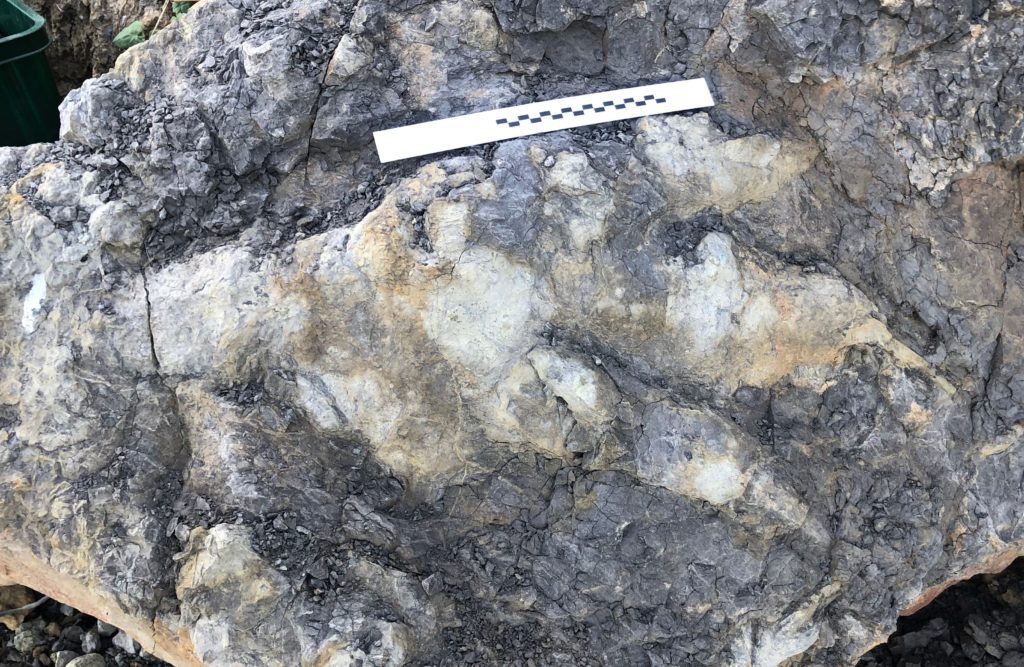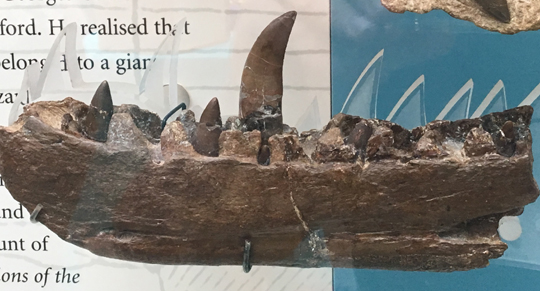A giant, carnivorous dinosaur left an unusual footprint in soft sediment approximately 166 million years ago. Remarkably, the print has been preserved as a fossil, providing palaeontologists with yet more evidence to demonstrate the diverse, dinosaur dominated ecosystem which has been preserved in the rocks that comprise the Yorkshire coast.
Giant Dinosaur Footprint
The trace fossil measures around eighty centimetres in length, and it was probably made by a large theropod dinosaur (Megalosauridae).

Picture credit: James McKay
The Yorkshire Coast
The Yorkshire coast is renowned for producing some visually and scientifically significant fossils, including thousands of dinosaur footprints and tracks. A popular destination for professional palaeontologists and fossil fans, people come from far and wide to see what they can discover.
The three-toed (tridactyl) print is exceptionally rare and unusual. It appears to record the moment when a meat-eating dinosaur crouched down or rested.
Discovered by a Local Archaeologist
The print was discovered in April 2021 by Marie Woods, a local archaeologist. She was walking along the coast and found this amazing trace fossil by chance. Marie contacted local fossil experts to see if the print had already been recorded, but none of them were aware of the track she described.
Dr Dean Lomax, a vertebrate palaeontologist affiliated with The University of Manchester was contacted and asked to examine the fossil find.
Dr Lomax, a co-author of the study published in the Proceedings of the Yorkshire Geological Society commented:
“I couldn’t believe what I was looking at, I had to do a double take. I have seen a few smaller prints when out with friends, but nothing like this. I can no longer say that ‘archaeologists don’t do dinosaurs’. At the time of the discovery, it generated a lot of public interest and I was overwhelmed with the messages on social media from people around the globe.”

Picture credit: Marie Woods
An Extremely Significant Fossil Discovery
The footprint is one of only six similar prints to have been recorded in the area, the first of which was identified in 1934. This print is an extremely significant fossil discovery, not only are tridactyl prints rare, but this trace fossil is the largest found in Yorkshire to date.
Local geologist and lead researcher on the paper John Hudson explained:
“This important discovery adds further evidence that meat-eating giants once roamed this area during the Jurassic. The type of footprint, combined with its age, suggests that it was made by a ferocious Megalosaurus-like dinosaur, with a possible hip height between 2.5 and 3 metres.”
Dinosaurs of the British Isles
Megalosaurus (M. bucklandii), was the first dinosaur to be formally described (1824). Around a hundred different dinosaur genera have been described from fossils found in the British Isles. Such is the significance of dinosaur fossils from the UK, that Dr Lomax was inspired to write a book documenting the extensive dinosaur fossil discoveries that have been made on these islands.
To learn more about the work of Dr Dean Lomax and for further information on the books that he has written: British Palaeontologist Dr Dean Lomax.

Picture credit: Everything Dinosaur
A Fragile Fossil
Photographs shared between the research team led them to conclude that the specimen was exceptionally fragile and likely to suffer further damage if it remained on the shoreline. Action was taken to rescue the fossil. The dinosaur trace fossil was expertly recovered by experienced fossil collectors Mark, Aaron and Shae Smith of Redcar.
As the rescue mission progressed it came to light that the print had been spotted five months previously, by Bob Taylor a local fossil collector who subsequently helped to write the research paper on the specimen.
Dr Lomax thanked Mark, Aaron and Shae for ensuring the safe recovery of the fossil and he stated:
“We’re incredibly grateful to Mark, Aaron and Shae for rescuing this important specimen and ensuring that it was saved for science. Now that the specimen has been studied, plans are in motion for it to go on public display, to spark the imagination of the next generation of fossil hunters.”
Donated to Scarborough Museum and Galleries
The fossil has been donated to Scarborough Museum and Galleries. Plans are in place to include this remarkable dinosaur in an exhibit, once conservation has been completed.
Dr Mike Romano (University of Sheffield), an expert on dinosaur tracks and other trace fossils, also co-authored the scientific paper. Dr Romano has spent more than two decades researching the dinosaur tracksites associated with the coast of Yorkshire.
He added:
“The east coast of Yorkshire is known as the Dinosaur Coast for very good reasons”
A huge number of dinosaur tracks, ranging in the thousands, have been discovered. As a result, this stretch of coastline is considered one of the best places in the world for dinosaur footprints. Although the first prints were documented in 1907, it was not until the 1980s that finds were being reported on a regular basis (by amateurs as well as professional geologists).
Twenty-Five Different Types of Track Described
Around twenty-five different types of footprints have been identified from the Jurassic strata exposed on the coast of Yorkshire. These prints and tracks demonstrate that during the Middle Jurassic a diverse, dinosaur-dominated ecosystem thrived in an ancient coastal plain environment. The trace fossils also recorded behaviours, palaeontologists have identified trace fossils that indicate walking, running and even swimming dinosaurs.
A Dinosaur Behaviour “Locked in Time”
Dr Lomax outlined how this single print can help scientists to better understand theropod dinosaur behaviour.
He commented:
“This is a wonderful find. Not only does this specimen represent the largest theropod footprint found in Yorkshire, but by studying the angle of the footprint, its shape, and the impressions of the claws, the fossil provides insights into the behaviour of this individual from around 166 million years ago. In fact, features of the footprint may even suggest that this large predator was squatting down before standing up. It’s fun to think this dinosaur might well have been strolling along a muddy coastal plain one lazy Sunday afternoon in the Jurassic.”
This is an example of the behaviour of a long extinct prehistoric animal being preserved in the fossil record, a footprint that provides evidence of the behaviour of a dinosaur that has been dead for 166 million years.
Dean Lomax is also the author of “Locked in Time”, a book which examines animal behaviour preserved in fifty exceptional fossil discoveries.

Picture credit: Everything Dinosaur
Everything Dinosaur acknowledges the assistance of a media release from the University of Manchester in the compilation of this article.
The scientific paper: “A new giant theropod dinosaur track from the Middle Jurassic of the Cleveland Basin, Yorkshire, UK” by Hudson, J. G., Romano, M., Lomax, D. R., Taylor, R. and Woods, M. published in the Proceedings of the Yorkshire Geological Society.






Leave A Comment